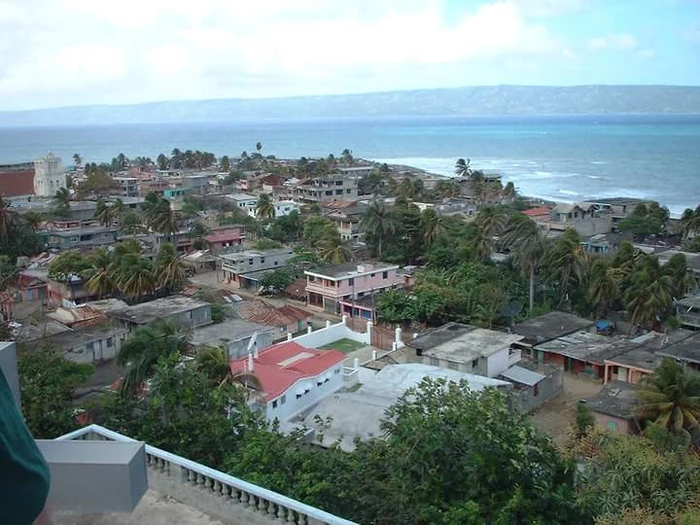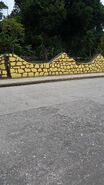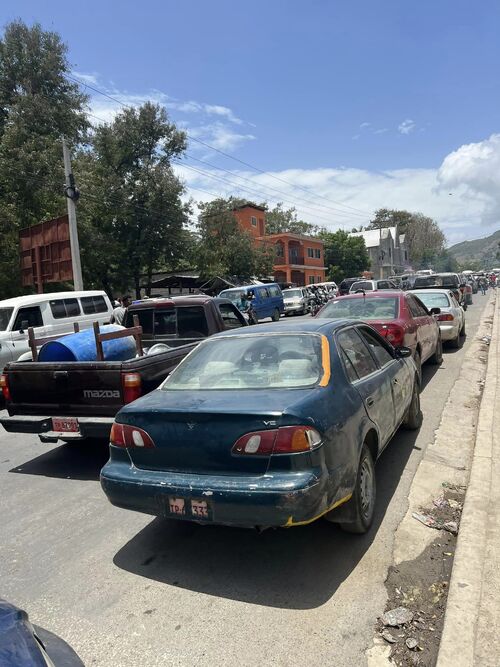"A society is defined by what it will not tolerate."
Yon sosyete defini pa sa li pa pral tolere.
-John Rawls
Saint-Louis-du-Nord (Kreyol: Sen Lwi dinò) is a commune in the Saint-Louis du Nord Arrondissement, in the Nord-Ouest department of Haiti. In 2015, it had 116,350 inhabitants.
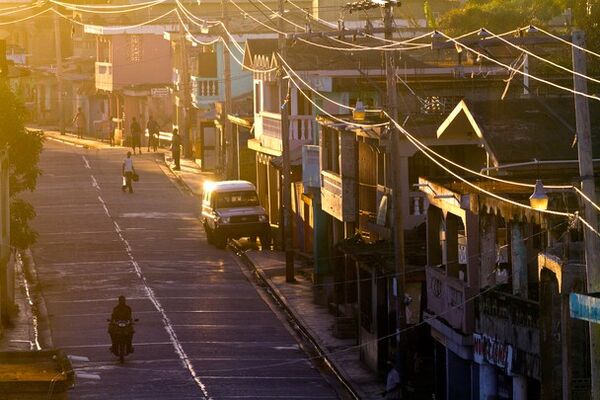
Sunrise in St Louis du Nord, Haiti.

Welcome sign
Environment[]
Saint-Louis du Nord enjoys a beautiful environment. Considered to be one of the one of the finest in the country, its landscape varies from wooded hills and flowing rivers to waterfalls and the seaside. This nature is one of the greatest riches of the municipality. According to the MARNDR census, it has more than 400,000 trees, at least a fifth of the quantity of the whole department.
About[]
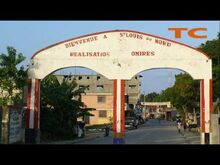
Welcome sign
Saint-Louis du Nord is one of the oldest cities in the country, founded in the 17th century during the buccaneer era. At the time, this small community of pirates had settled just across the way on Turtle Island: the island served as a hideout for them to attack the Spanish, French and English galleons (depending on the periods of domination). After several years of buccaneering, one of the French occupants of the Island, Bertrand d'Orgeron, undertook to stabilize and organize this small colony. Thus, in 1665, he was appointed first Governor of the island by France, responsible for developing what was to become the colony of Santo Domingo. Saint-Louis du Nord thus emerged during those years when the French colonists landed on the “Grande Terre”, from the Ile de la Tortue. Governor D'Orgeron then called the region by the patronymic of King Louis XIV, “Petit Saint-Louis”. The municipality successively went through several name changes such as Les Palmistes, Derouvray and Tire-lire. A few vestiges remain from this period: for example those of the dwelling of Bertrand d'Orgeron near Bonneau; or those of the first Colonial Bank which served Santo Domingo and the French West Indies, at Forges.
Today, the town of Saint-Louis du Nord is a provincial town as large as some departmental capitals. Over the past few decades, its cultured profile has earned it the nickname "the cradle of the intelligentsia", while its productive, verdant hills have made it the "breadbasket of the Northwest". However, Saint-Louisians feel that this reputation no longer fully reflects today's reality. Life is not easy for the 80,000 inhabitants of the communal sections, very far from all services; nor for city dwellers, whose number increases sharply every year. The population feels neglected by the State, and is often assimilated to the rest of the department, while the municipality presents a profile - and a potential - radically different.
The City of St. Louis du Nord was founded around 1606.
The flourishing village owes its establishment to the abandonment of the Île de la Tortue before 1695. It is located on the Canal de la Tortue, in a small plain by the sea at the foot of a nipple showing a pleasant look; its temperature is healthy. Its port is a small basin formed by reefs exposed to all winds, only accommodating small boats.
History[]
• In May 1865, St. Louis du Nord after joining with the Salnave insurrection, made its submission to the government of President Geffrard.
• In October 1888, Toussaint Louverture, government warship, captured a boat of the northern insurgents in the port of St. Louis.
• Joseph Justin who was Secretary of State was born in St. Louis du Nord.
• On July 4, 1915, a accidental fire broke out in Saint Louis du Nord at a merchant by the name of Charles Elysee. The Government decided to come to the aid of the disasters and voted, by a law of September 21, 1915. a value of thirty five thousand gourdes to be distributed between the disasters by a local commission. According to the investigation, no value was paid. Monseigneur Jean Louis de Bellegarde was Duke of St. Louis du Nord under the Empire in 1849.

Ville de Saint-Louis du Nord, Haiti
Geography[]
Saint-Louis du Nord is located in the Northwest Department in the sub-region commonly called Haut Nord-Ouest (Upper Northwest). It is a mountainous area, at the end of the Massif du Nord and a coastal region, facing the Canal de la Tortue. It is located at 19.9276° N, 72.7141° W. According to the IHSI, this commune has a total land area of 125.60 square kilometers (48.49 square miles), of which 76.26 sq.km (61%) is suburban, 46.43 sq.km (37%) is rural, and 2.91 sq.km (2%) is urban. It is bordered on the east by the town of Anse-à-Foleur, on the southeast by the Northern Department city of Borgne, on the south by the Artibonite Department city of Gros-Morne, and on the west by the towns of Bassin-Bleu and La Pointe. Saint-Louis du Nord is split into 6 communal sections and two districts, Bonneau and Guichard. Four of these sections are coastal areas whose land area consists of either plateau, mountains or plains. Bonneau is home to a new 1.6 mw power plant. Similar to the urban area, the district of Bonneau is a hilly coastal area with a tropical temperature. The district of Guichard is a mountanous inland area with a tropical climate.
Saint-Louis du Nord is Haiti's 26th most populous municipality. It ranks 122 out of 145 in land area, making it Haiti's 8th most densely populated commune.
The law of November 20, 1831 fixed the precise distance from this commune to the capital at 53 leagues.
Saint-Louis du Nord is 260 km (162 miles) from Port-au-Prince, 105 km (65 miles) from Gonaïves, and 65 km (40 mi.) from Jean-Rabel, in the Lower Northwest. Cap-Haïtien can only be reached by an impassable track passing through Borgne, or by boat.
The Rivière des Negres waters this city. Sometimes it threatens to flood the village. The waters emerge from the heights of Rouvray; Rue Alexandre, le Marché and Rue Cap-Haitien. A fairly wide masonry canal from Fort Robin would alleviate the flooding.
Neighborhoods
| SLN | Saint-Louis du Nord | 116,350 | |||
|---|---|---|---|---|---|
| VLN | Ville de Saint Louis du Nord | Urban | 36,602 | ||
| QGU | Quartier de Guichard | Urban | 321 | ||
| QBN | Quartier de Bonneau | Urban | 2,627 | ||
| RVN | 1ère Section Rivière-des-Nègres | Rural section* QGU | 11,931 | Bellevue, Colo Chambeau, La Colombe, La Galome, Villarseaux. | |
| DRV | 2ème Section Derouvray | Rural section | 10,406 | Beaumont, Brunel, Chêne, Dehouvray, La Ressource, Macken, Souffort, Tête Roche, Vertus. | |
| GNG | 3ème Section Des Granges | Rural | 16,732 | Balantier, Bellevue, Chapelette, Corail, Desgranges, Dos Lamarre, Fortin, La Perrière, Nan Milhomme, Nan Richet, Nan Savane, Rabouin, Saut-Barthe. | |
| RBA | 4ème Section Rivière de Barre | Rural | 18,031 | Abricot, Bassin Tournin, Berger, Boucan Chique, Cazal, Chateau, Couro Rochonne, Débaucher, Jean-Clair, Loman, Mapou, Nan Zabricot, Terre Grinnin, Toman. | |
| BNN | 5ème Section Bonneau | Rural section* QBN | 12,342 | Bonneau, Bouchereau, Cap Rouge, Cheneau, Fond-Brûlé, Gaspard, Liquette, Mathieu, Méyence, Nan Besoin, Nan Marc, Préto. | |
| LAF | 6ème Section Lafaque (Chamoise) | Rural | 7,358 | Baron, Chabotte, Chapelet, Chateau, Chica, Dos Bambou, Dos Bobo, Foloque, Glacis Couro, Guêtre, Mahotière, Pasteur, Tortue. |
Sections, neighborhoods, and town
Of the commune's 6 sections, only the 6th section has no access to the coast. Located in the hills to the south of the town, this section is the most remote and also the most difficult to access (in the absence of roads).
The commune has 68 large villages: the furthest are more than 3 hours' walk south of the line (and up to 8 hours' walk for Forlock). The 6 sections include a total of at least 528 localities.
| Habitations/villages | ||
| Bwa Chandèl, Tonette, Neptune, Rivière Salée, Fortin | Trois Carrefours, Roche Ronde, Cazalie, Mouche André, Vital | Brunel, Au Four, Mapou I, Liquette, Chamoise I |
| Cagond, Bike, Mapou II, Chaineau, Chamoise II | Terre Blanche, Gran Lakou, Gaspard, Kafoulwima, Forlock I | Beaumont, Corail Balatier, Ménage, Pretou, Forlock II |
| La Ferme, Balatier, Jean Clair, Nan Mazi, La Tortue - Guedon | Kafou Granbwa, Glacis Kouro, Berger, Chabotte | Chavary, Corail Guichard, Cap Rouge, Nan Tante |
| La Perrière, Bertrand d'Orgeron, Caheau | Rabrun, Debaucher, Le Trèt |
Demography[]

The inhabitants of this commune call themselves Saint-Louisien/ne.
| Year' | Population | Change +/- |
|---|---|---|
| 1890 | 10,000 | |
| 1982 | 42,292 | +323% |
| 1998 | 52,062 | +23% |
| 2003 | 69,592 | +34% |
| 2009 | 105,808 | +52% |
| 2012 | 111,070 | +5% |
| 2015 | 116,350 | +5% |
At 3.3% per year for several decades, Saint-Louis du Nord has one of the highest growth rates in the country. If no measures are taken, the population could more than double by 2037 and exceed 230,000 inhabitants, leading to greater pressure on resources, an extension of the city, and slum development. This strong increase in the population is more likely due to a high fertility and birth rate than to migratory flows. Effective family planning is in high demand, though there are no precise figures. This trend is proven by several concordant sources of information, in particular, the 1982 census, showing 42,292 inhabitants (8,076 in urban areas; 34,216 in rural areas).
The urban area of Saint-Louis du Nord, which, with approximately 36,000 inhabitants, concentrates 30% of the population: it is dense and relatively large (the first in the Northwest after Port-de-Paix); - the entire coastal zone, which is densely populated, stretches along the road, from the 1st section (Villaceau), through the urban area, to the 5th (Bonneau and Rivière Salée). This large population (estimated at around 32% of the total) is explained by the facilities it derives from flatter land, transport, and the seaside. In the hills, the population is estimated at around 43,000 people (38%); At least half live more than an hour's walk from most services and the road. The other half lives even further away in the hills, more than 3 hours of hard walking (this very remote area generally corresponds to the south of the town). This is the entire population of the 6th section, and the highest part of the 3rd and 4th sections. This last fringe of the population (the "remote areas") appears to be the most disadvantaged (access to water, social services, migrations, etc.).
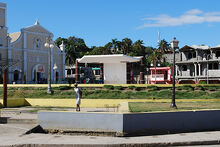
Saint-Louis du Nord

New 1.6 megawatt generator; Bonneau, St-Louis du Nord, Haiti
Land characteristics[]
The entire coastal strip - town and hills, from Port-de-Paix to Anse-à-Foleur - is semi-rural, with relatively dense villages, for example in Guichard, Bonneau, and Abricots. Then there is the urban area of Saint-Louis du Nord: it extends over about 3 km (2 mi.), in length. The main street is completely covered with concrete (since 2006); a secondary, parallel street is also concreted. At its eastern exit, the Desgranges district is also urban in character: it is located just after the Petite Rivière, on the territory of the 3rd section. It extends to the mouth of the Rivière des Barres, where the largest market in town is also held. The city's habitat is very dense: about 4,000 houses in a compact area (about 2.3 km² {0.88 mi²}). The city continues to expand little by little, both along the coast and towards the hills (Sous-Fort, Sous-Terrain).
Leaving the coastal strip, the hills begin towards the south. This is the vast majority of the municipal territory, with a very hilly relief. The hills are steep, quickly reaching 400 m (1,312 ft.) in altitude, and even up to peaks around 900 meters (2,950 ft.) to the southwest (at the foot of Haut Piton, behind Chavary and Rabrun). This whole area is very rural, the habitat is more dispersed but still relatively dense. The hills are generally still heavily wooded in places, but less and less in others. They are predominantly karstic; the soil is generally calcareous with a brown color.
Seismic Risk[]
A fundamental characteristic of the town is the very high seismic risk it presents, because the North (or Septentrional) fault passes right at its foot, in the Canal de la Tortue. The last significant earthquakes along this fault date from 1842 (Cap Haitien) and 1887 (Port-de-Paix); in addition, tsunami phenomena have often accompanied earthquakes in this region over the past centuries. This is undeniably the greatest threat to the town - especially since it is heavily populated, the concrete constructions do not comply with any seismic standards and are built haphazardly, including in risk areas (edge of sea). The Canal de la Tortue fault passes just below Saint-Louis du Nord. The seismic risk is aggravated by the poor quality of the construction.
A “Great North Earthquake Plan” (2012-15) was implemented by the UNDP, in collaboration with Ministries and Civil Protection.
Climate and Rainfall[]
Saint-Louis du Nord enjoys a humid climate, clearly distinguishing itself from the municipalities of the Lower Northwest; it is the rainiest municipality in the department with an annual average of around 2,000 mm (80 in.) (compared to 600 mm/ year (25 in.) in the Lower Northwest). The prevailing wind is the trade wind coming from the northeast, loaded with humidity. Blocked by the high peaks, it causes frequent showers. The water balance is positive; a large quantity of water remains in the soil. Rainfed agriculture is thus facilitated in the lowlands of the municipality, making it possible to limit the use of irrigation systems. The rainy season extends approximately from November to March. Note that the period is almost reversed compared to the rest of the country, which is explained by the winds and mountain barriers. However, the rains are not regular from year to year. In addition, they cause floods, frequent and strong, particularly along the coast and in the urban area. The hurricane period extends approximately from July to October. The hills are then very exposed to winds and rains. The coast too, during cyclones, is often flooded by the sea.
Economy[]
The local economy is based on agriculture, livestock, and trade.
Saint-Louis du Nord and its region is generally known as the “Grenier du Nord-Ouest” (Granary of the Northwest). It is therefore not surprising that North Saint-Louisians consider agricultural potential precisely as their greatest asset, which nevertheless deserves to be strengthened. It should be remembered that Saint-Louis du Nord is fertile land with still significant plant cover and plenty of water. Traditionally characterized by production on 3 levels of vegetation, this system tending is to fade... Today, the production of coffee and cocoa has fallen sharply. Similarly, the quantity of fruit trees (lemons, avocados, oranges, and mangoes), although still significant, decreases in the hills and in the markets. The main crops are musaceae (plantain, banana, etc.), yam, maize, sweet potato, and cassava, as well as certain vegetables (shallots, carrots, cabbage, lettuce). The true tree, a resistant species with strong regeneration, is also very widespread. With these crops, subsistence agriculture is used to cover personal needs and possibly build up a small capital.
Agriculture[]
Agriculture, despite its potential, is therefore not doing well. Many factors are cited, but in particular tree cutting, erosion, loss of fertility, lack of technical supervision and training, the lack of seeds, and the almost total lack of information and data on agriculture are also causes.
Some have considered setting up an agricultural training school on available State land located in the 5th section. In addition, concerning the 6th section, many farmers are heading towards Pendu (commune of Gros-Morne) to sell their products - which does not however call into question their feeling of belonging to the commune of Saint-Louis. For them, trade could be further promoted with this neighboring municipality (very focused on the mango sectors and falling within the national strategy). Finally, there are many grassroots organizations active in agriculture (Gaspard Peasant Organization, Association Paysanne pour le Développement de Berger, etc.). Some are members of larger networks, such as Tèt Kole and MPNKP. Opportunities can also come from large cooperatives or from abroad: for example COCANO is working in the Northwest on the export of coffee, in collaboration with CRS, St Thomas University and the Archdiocese of Miami.
Stockbreeding[]
Although they consider it a secondary productive activity compared to agriculture, Saint-Louisians value stockbreeding because it provides them with additional income to take on family responsibilities. The climate, the coffee and fruit agro-systems, and the presence of free land on the plateaus lend themselves above all to cattle and pig farming. It is also the type generally favored by farmers. Despite this preference, there are however goats in greater numbers in the town. In all cases, breeding is practiced by rope. There is also a lot of poultry.
The Gaspard market is the main place where livestock are sold. Mounted animals are found there in large quantities. They are used to transport food and commodities from the sections to the towns and/or outlet markets. In coastal areas, they are used to transport building materials (sand, gravel); and sometimes, in the most remote areas, to transport the sick.
Fishing[]
For a coastal municipality, this sector remains relatively marginal. As a result, there are few fish and other seafood products on the markets. Today the number of fishermen is low and the fishing techniques rudimentary. The sector would be more attractive with the existence of organizations of fishermen and intermediaries to ensure the conservation of products and the sale, as well as the development of more efficient fishing techniques. This would also make the city more suitable to face competition from imported products.
Only small to medium-scale fishing is practiced in Saint-Louis du Nord, which demonstrates the embryonic state of the sector.
Charcoal production[]
Charcoal used to come from the Lower Northwest on the back of a donkey. In recent years, mass production has been done directly in the Upper North West. In Saint-Louis du Nord, it is produced mainly in the 3rd section (Glacis, La Perrière, Rabrun) and the 6th section (which also serves Gros Morne). Coal also comes from Anse-à-Foleur (1st section); but especially from Turtle Island. La Tortue coal is traditionally considered higher quality because it lasts longer. Wholesalers buy the surpluses that come from La Tortue, in order to resell them at a higher price in the rainy season (between November and March). This higher price of coal from La Tortue leads to an astonishing practice: the coal from Anse-à-Foleur often passes through the Ile de la Tortue, to then arrive at Saint-Louis du Nord, leading people to believe that it comes from La Tortue (for its best quality). In Saint-Louis du Nord, coal is mainly used for consumption (dry-cleaning and bakeries) in town, in the absence of an alternative. The bag of charcoal costs between 200 and 250 gourdes; in the rainy season, it rises to 400 G. In the communal sections, on the other hand, wood is used for cooking.
Trade[]
Trade is a very popular activity for many people in the municipality; however, this sector suffers from many weaknesses, both in terms of locations and infrastructure, products sold, and capacities and organization. The major place of shopping activities is the market at Rivière des Barres, located at the exit of the city (near Desgranges). Taking place every Wednesday and Saturday, it has around 2,000 traders, mostly female. This market is a gathering point for the whole region, even beyond Anse-à-Foleur, La Tortue and Port-de-Paix. Despite its importance, it is nevertheless extremely precarious: the market is located in the very bed of the Rivière des Barres, near the mouth. Hygiene is non-existent there. it has no facilities or amenities, and above all is very vulnerable during the rainy season due to its location (frequent flooding). The 2nd major market is the Saint-Louis market (at the bottom of the village: up to about 500 merchants every day). On the other hand, the Bois-Chandelle market, built in 1998, is not functional. It was built too far from the city, and the road to get there is not developed.
The products sold in these markets are mainly of three types: 1) agricultural products, distributed throughout the commune by Madames Saras (intermediaries), or sometimes farmers; 2) imported products, which represent a large part of the trade (such as oil, rice, manufactured products, frozen meats, etc.); and 3) construction materials, also distributed in stores and depots. In town, there are also more than 230 boutiques, 6 stores and 6 small "markets". In the communal sections, these establishments are almost non-existent, on the other hand there are 12 markets. Concerning the transport of goods, trucks come from Port-au-Prince and Port-de-Paix. There are also regular sailboats from Cap Haitien to the various ports of the town (mainly in Saint-Louis du Nord, and in the 5th section in Berger and Rivière Salée). Various microcredit institutions exist: first, offices such as COOPECS, CONAC, CAPS and National Microcredit (which is a service provided by Unibank). But many traders also take informal credit - often at very high interest rates. Finally, the diaspora also supports small and medium traders, in particular to facilitate a start-up fund.
A few businesses in town: water and ice cream factories, bakeries, shops, restaurants and hotels, markets, gas stations, clinics, morgue, schools - A few credit unions that grant loans (CONAC, COOPECS, FONKOZE, CAPS, Mutuelles de solidarité).
Industry and Services[]
The industry and services sector is underdeveloped. There are various types of businesses, almost all of them in the town: 2 drinking water plants (one of which also does refrigeration), a cold room (ensuring the sale of imported frozen products and soft drinks), a gas station, and several (small) establishments. Miscellaneous industries and services in the town include copying, photo, transfer, sale of telephones, land surveying, sale of glasses, a medical laboratory, 3 radio stations, funeral companies, sewing, welding, and cabinetmaker workshops, pharmacies, restaurants, beauty studios, markets, garages, shops, hotels, bakeries, and dry cleaning. On the other hand, local product processing activities are almost non-existent (apart from mamba and a few jams).
Markets in the communal sections:
1st: Villaceau; 2nd: Bois Chandelle (non-functional); 3rd: Glacis Kouro; 4th: Gaspard, Ménage, Fonds-Philippe; 5th: Bonneau, Berger, Chaineau; 6th: Chamoise I, Chamoise II, Guedon
In the communal sections, there is almost no business. There are still some activity, such as twenty bakeries, more than 120 sewing workshops, and more than 200 cabinetmaker workshops. The latter are found in very large proportions in Glacis (3rd), Gaspard (4th), Berger (5th) and, above all, Abricots (4th). Throughout the town there are also many masons. A big obstacle for the development of entrepreneurship is the municipality's lack of electricity.
Exploitation of mines and quarries[]
There are several rocky places in the sections, but this is not a sector of great importance for the municipality. The banks of the Rivière des Barres as well as the coastline are used for the supply of sand and gravel. They are mainly used for the construction of houses and the paving of dirt roads (through community actions). However, these resources are very badly exploited and are not adapted to the needs (gravel too coarse) or of poor quality (sea sand), the technical means are lacking and there is no follow-up by the authorities.
Tourism[]
The town has real tourism potential, in various ways. First of all, the natural sites are certainly one of its greatest attractions: magnificent wooded hills, numerous rivers, basins, and caves, and beautiful beaches. The city of Saint-Louis du Nord has several natural and historical assets, like Roche Ronde, the ruins at Forges, and the beach at Cap Rouge. The table lists at least 15 important waterfalls (some easily accessible), at least 35 forts or historical remains, 7 pilgrimage sites and 10 mystical places (including the Vilokan, known as one of the most mystical places in the country, "link between the land of Haiti and Africa"). Other mystical places include Nan Tante, Lavilokan Tou deman (La Perrière), Vye Chouk (Bike), Dete Sapotine, Zinga and Nan Pika (Glacis Kouro), Corail Guichard, Pied Mapou aux Abricots, Nan Youyou, and Nan Titou (Le Traite).
The potential iof tourist sites is however very little valued because in the current state these sites are not developed and often little known to the inhabitants themselves . Several vestiges are occupied and degraded by the inhabitants, who do not know the history of the settlers who lived there. In the hills, the populations are not at all ready to receive tourists: no development of paths, no reception capacities, no accommodation or catering, and no information on the sites to be highlighted. The caves are notably in the 4th section at Mapou, Modès and Jean-Clair.
Other key economic indicators include an Albaster quarry, rubble stone, chalk, and limestone spar. Wood for construction and marine timber also contribute to the commune's thriving trade sector.
A coffee factory set up by Alfred William provides food from Fort Liberte to Gonaives.
Employment
The formal employment sector has only a tiny workforce compared to the total population. Although we do not have precise figures, it can be argued that the education sector occupies the first place by far, followed by state services, servants and shop employees. The private sector, through certain entities with legal status, provides a few formal jobs (examples as diverse as the ice factory, the Yanick Lahens library, the Christian Mission and some NGOs, or the COOPECS). But the majority of family income (apart from direct agricultural production) comes from informal employment. It primarily is made up of retail traders, craftsmen and agricultural workers. This lack of formal employment pushes more educated citizens in particular to try their luck elsewhere.
Infrastructure[]
Transportation

Ville de Saint-Louis du Nord
Most of the streets are gravel, both in the center and in the communal sections. They are in bad shape.
The major problem of the commune is the isolation of the communal sections, due to the roads and transport. All activities, such as basic services (education, health etc.), administrative services, and commerce, are made difficult (or impossible) due to the absence of roads. The unique main road of the commune, which runs along the entire coastal strip from the Rivière des Nègres river towards Bonneau and Anse-à-Foleur, is in fact only a track in worn-out condition (many potholes) which crosses five wide rivers. When these are in flood, access and passage between the different areas becomes almost impossible. This is why the construction of an asphalt road, included in the national plan of the Strategic Development Plan of Haiti, is terribly long overdue.
In addition, the isolation of the communal sections and, thus the population, is significant, for lack of roads or even paths. Indeed, the disastrous state of the paths only allows motorbike travel (generally with difficulty) along the coast and at the bottom of hills.
Almost everywhere else, travel can only be done on foot: towards Beaumont and Chavary (2nd section); towards La Perrière, Glacis (3rd) and the entire 6th section; towards Gaspard and Jean-Clair (4th), as well as towards Chaineau (5th). However, nearly half of the population lives in these remote and inaccessible areas. The paths are so bad and narrow that even donkeys cannot pass; in the rainy season, the situation becomes even worse because travel requires hours of walking in the mud.
In the urban area, the main street is concreted (as well as the parallel street) but it stops at Petite Rivière, at the entrance to Desgranges. The absence of a bridge over this small river cuts the town in two and prevents it from having a single approach. There is only a fragile footbridge over the Petite Rivière, between the city center and the Desgranges district. This absence of a bridge cuts the city in two (especially during heavy rains).
Concerning maritime transport, it is very little used until now. The reason is surely the total absence of a wharf. There is, however, a great potential for exchanges, in particular towards Tortuga Island in Cayonne (port just opposite, at the foot of Haut-Palmiste) and Les Figuiers (further to the east of the island), as well as to Cap-Haïtien, which transports many goods by sailboat. It should also be noted that the North Louisians barely have boats: almost all of them come from La Tortue and belong to the Tortugais.
Education
Saint-Louis du Nord has long been known as the "cradle of the intelligentsia",
The Ministry of the National Youth and Sports Education is represented in the municipality of Saint Louis of the North by three inspection offices. More than half (60%) of the schools are located in the center. Overall, the municipality has 88 preschools, 19 primary schools, and 13 secondary schools. There are 2 public high schools, La Mennais and Serge Petit Frère. 88% of the schools are private.
Trends show that the children of the communal sections, not finding a valid rural school offer, increasingly have to go to school in the city center. This is particularly true in the first 3 sections, as they are closer to downtown. In these sections, school attendance is extremely low, even though they are very populated areas.
This overall deficiency in supply, particularly in high schools and even secondary schools, is also a cause of the exodus of students: mainly to Port-au-Prince (about 65% of students who leave the town), and to a lesser extent to Port-de-Paix, the Dominican Republic and Cap Haïtien.
Vocational training is provided by the Pierre Ridgeway College. With limited resources, this school offers technical training in plumbing, electricity, household arts, IT, and cooking.
There are a few dynamic civil society associations and trade unions that are committed to improving the quality of education (e.g.: support and remedial courses by the CRI; AFP training courses in Port-de-Paix; etc.). The NGO Initiative Développement has been working since 2010 to support schools in the district and build the capacities of education stakeholders; Sport Sans Frontières has been in the deployment of sports and awareness-raising activities; and the GREF carries out periodic capacity building missions for school principals. Compassion International and religious missions provide financial and educational support to certain schools (Baptist or Catholic) through a sponsorship system.
Healthcare
The municipality of Saint Louis of the North has two health centers, five clinics, and two laboratories. In the national classification relating to health care access, Saint-Louis du Nord ranks 130th. Even if certain aspects have improved since this classification, the health situation is insufficient, in relation to the size and needs of the population.
The impression of a distribution of dispensaries on the territory, should not mask the fact that they are very difficult to access, and cruelly lacking in equipment and personnel. Very few of these settlements are easily accessible: most of them are far from neighborhoods, and suffer from recurrent flooding of rivers and bad paths. The municipality is therefore very isolated and under-equipped in terms of health. For the slightest complication or more specific intervention, patients are obliged to go to the Béraca Medical Center (CMB, in La Pointe, nearly 30 minutes by car from Saint-Louis du Nord in the direction of Port-de-Paix), or the Immaculate Conception Hospital in Port-de-Paix, while enduring the difficult dirt road.
In general and in theory, health centers operate full time; but they have many structural, material and technical problems. The most common services offered are general consultations, family planning, vaccination, hospitalization, laboratory analyses, pharmacy. Tuberculosis screening and treatment are carried out at the Saint-Louis Community Hospital, as well as at the Saint-Joseph health center in Bonneau. By appointment, surgery, prenatal and maternity care (although without the means to perform cesarean sections), oral care and ultrasound can be offered at the Christian Mission (NWHCM). In the communal sections, "modern" services are almost absent. The few dispensaries only operate on a part-time basis with a limited service.
Regarding doctors, the ratio is 1 doctor for about 20,000 inhabitants, well below the national average of 1/10,000. nutrition funded by the Foundation for the Development of the Haitian Family (FONDEFH), through the Haitian-Austrian Community Hospital of Saint-Louis du Nord. There are more than 230 midwives and health workers distributed in all the communal sections. There are also many other players in the sector: 56 "bone doctors", a large number of masseurs, and 3 tooth pullers (on the other hand, no dentist). Alongside modern medicine there is a very present traditional medicine (“leaf” medicine or “Guinen” medicine). For the vast majority of the population, it represents the first resort in the event of a health problem. It is based on plants and is the subject of a transmission of knowledge.
Saint-Louis du Nord is home to the St. Louis du Nord Municipal Hospital
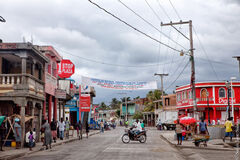
Saint-Louis du Nord, Haiti
Utilities
Water The municipality of Saint-Louis du Nord has at least 378 sources, of which a fifth (77) are captured. These sources are primarily found in the heights of the hills (mainly in the 3rd, 4th and 6th sections). This is also where the strongest flows are found. By summing up all the sources in the territory, the quantity of water available at this level represents at least 50L/d/inhabitant, which is more than double the current consumption (which is around 20L/d/inhab. ). Consequently, the springs could be sufficient to cover all the water needs of the population of Saint-Louis du Nord.
Along the coast, the water table is shallow; 2 or 3 m (6 to 9 ft.) below ground level. Between 30 to 50% of the inhabitants of this area therefore have this additional water resource, thanks to the many wells. It should be noted, however, that this water table is often contaminated by the pits of the latrines, which are not sufficiently sealed.
Power
The urban area and two other communal sections (the 1st and 3rd) are electrified by l'EDH by means of electric motor.
The need for electricity and the great wind potential
The lack of electricity is one of the biggest problems of the municipality. The city only has a 500 KW installation - in the courtyard of the Town Hall - which operates irregularly depending on the financial contributions to supply it. This installation is very insufficient compared to the size and therefore to the needs of the city, the 2nd largest in the Northwest.
A remarkable potential also exists in the Upper Northwest, that of wind energy. An in-depth study on this subject was carried out six years ago: analytical and detailed, it demonstrates the "exceptional potential on Turtle Island and on the coast facing it" (that of Saint-Louis du Nord). Available on the website of the Bureau of Mines and Energy, it adds that this area “seems to have better potential than Cap Haitien, which itself has better wind than Fort Liberté”. Located on the coast and slightly in altitude, this area is very exposed to the trade winds. Wind turbines would benefit the entire region of Saint-Louis du Nord and Bonneau, including as far as the neighboring town of Anse-à-Foleur.
Both from an environmental and economic point of view, wind energy for individuals and cities is a new economic sector using skills that already exist locally and can help boost this sector of activity, particularly in rural areas or small isolated towns. Finally, the other great potential is obviously solar energy, which is considerable although still too little used. The Ministry Delegate for Energy Security with the “Banm limyè, Banm lavi” Program is very active in this area with the mission of working together in order to deploy all the potential wealth of the region.
Sanitation
Despite the lack of waste management, the relative cleanliness of the town is made possible, thanks to the bins financed by COOPECS, and the municipal road service. The marine environment faces a degradation risk due to a variety of factors like erosion, cutting of mangroves in the 5th section, uncontrolled fishing, plastic waste, and the destruction of coral reefs. This is perpetuated by a lack of citizen awareness regarding their environment and the effects of waste.
The city is on the edge of the Parc de la Citadelle. However, in the Strategic Development Plan of Haiti (PSDH, 2012), the government undertook to protect this park, and to identify other areas and natural sites to be protected.
Security
The garrison is made up of a gendarmerie company; one of administrative police, one Port-de-Paix line artillery, the national guard on foot and on horseback, and the rural police.
Administration
The City Hall of Saint-Louis du Nord is managed, as required by law, by a council of 3 elected members, including a Principal Mayor.
Culture[]
Saint-Louis du Nord still enjoys a reputation as an educated and cultured commune. Especially in the city center (and sometimes in the communal sections, for example in Bonneau), there are young people and adults interested in culture, literature, the development of ideas, about fifteen dance troupes... In the communal sections, there are still many traditions; however, many people consider that the local culture is in danger. More and more imported products, clothes, and foreign music are consumed and there are many who live with the ideal of American culture. For example, there are about fifteen rap groups in the town; but very few (if any) compa groups. The biggest event in the town, the patronal feast (August 25), known throughout the department, is the occasion of a big party lasting one to two weeks. It could be an opportunity to further highlight local culture and initiatives.
Religion
This commune is noted for its pretty church which throws an annual feast on August 25th. Concerning religion, the most widespread in Saint-Louis du Nord is Protestantism. There are more than 120 Protestant churches in the commune, almost half of which are Baptist. For the Catholic religion, which is also widely practiced, there are around 30 churches, a good part of which are in the 3rd section. Adventist temples are present too. Finally, the voodoo religion is very present. It is impossible to know precise figures; but the survey carried out indicates more than 70 peristyles and 410 badjis (for approximately 370 hougans and bokors, and 110 mambos). Voodoo is extremely strong in the 2nd section; but some complain about it, sometimes finding that it takes up too much preference over other activities.
There is also a Bethlehem Masonic Lodge. The orient lodge of St. Louis du Nord, belonging to the Grand Orient of Haiti is called Bethlehem N°44.
Organizations
The representation of two political parties is found in the commune of Saint Louis of the north. There are two women's groups, two peasant groups and two NGOs.
The associative fabric of Saint-Louis du Nord is very rich and diversified. There are all kinds of community organizations, associations or federations, both in town and in the communal sections. Some are registered with the Ministry of Social Affairs or at least with the City Hall; but in the majority of cases, they are not yet registered and are unaware of the steps to be taken to be registered. In the commune, several organizations are active such as ICIMOD, GASPNO, MODSA, CODESS, AMODD, CRI, and others, each in its own field(s). Special mention should be made of CAFDESA: the federation of women's associations of Saint-Louis du Nord and Anse-à-Foleur. Very broad and structured in committees in each section, it fights for everything that concerns women directly or indirectly, from social initiatives to fruit processing, etc. This association is an important relay for developing broad action with women. In the communal sections, there are a myriad of grassroots community organizations that are more rarely legally recognized. They lack resources, but are often motivated for any community project (roads, environment, latrines, awareness raising, etc; especially with the CASECs, the City Hall, the churches or the diaspora).
NGOs Only a few NGOs work in the commune. As of 2012, there was Koral (Haitian organization, active in community health and cholera prevention); Initiative Développement (ID, a French organization, currently active with a local development and education program); NDI (an American program); Hilfswerk Austria (active in health, and the origin of the community hospital); and the Christian Mission (American, with its health center in Sous-Fort). Occasionally, Caritas Haiti also develops projects in the communal sections, like the development of roads and watersheds. On the other hand, ACF (French, in the water and sanitation sector) and MSF have not worked in the HNO since 2011.
Communication
The municipality of Saint Louis of the north is equipped with a telephone service and three radio stations (Sensation FM, Shaddaï and Phénix).
Also, to meet the demand of the population, the stations relay Port-au-Prince radio stations such as Vision 2000, Signal and Scoop FM.
The written press concerns only a very small part of the population. The news arrives by plane or bus. Le Nouvelliste and Le Matin are thus on sale in Saint-Louis du Nord; others like Haïti en Marche or Haïti Progrès are more difficult to find.
Three mobile phone networks operate in the town, Voilà, Digicel and Natcom. These last two companies also have their store in town. However, none of these networks completely cover the municipality, especially in the upper sections. In addition, the antennas installed represent a real danger for the health of the population, both in the city center and in the sections. They are indeed found on roofs, or near houses and establishments. Finally, eleven cybercafés offer international call services, but only eight offer internet browsing. These are mainly frequented by the most educated young people in the city.
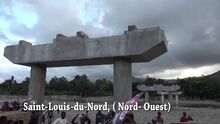
Leisure
Saint-Louis du Nord contains both fresh water, such as the source of Bertrand d'Orgeron in Cap-Rouge, and coastal beaches. The town is a beautiful destination for those who like to enjoy the sea, but also a good bath in the waters of a river. Magnificent beaches, in the town and also in Anse-à-Foleur, a healthy urban space, largely justify a tourist vocation, especially since the hotel sector is well organized.
It is also famous for its places of worship attracting spiritual people (vodouisants-es). Among its most famous sites is Ville-au-Camp, located in the first section of Rivière-des-Nègres. It is said that many statesmen (including presidents) go to these places to give thanks and ask for assistance.
There is also Dédée Sapotille, another so-called “mystic” located in Riviere-des-Barres. The commune of Saint-Louis du Nord also contains ancient vestiges such as the house of Governor Bertrand d'Ogeron and the parish of Saint-Louis du Nord.
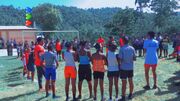
Guichard School; Saint-Louis-du-Nord, Haiti
As for the various establishments and leisure areas, there are four night clubs, seven gaguères, and a public square. Cinemas are expanding. In the sections, they often consist of a simple television and operate irregularly. The counted beaches are not all equipped and some of the discos (in rural areas) actually only operate during festive periods. On the other hand, the gaguères (cockfighting places) are very popular and numerous in almost the whole town. Especially young people (but also adults) are asking for more sports facilities. There are not enough football pitches (25), and they are poorly laid out. Only one field stands out clearly in town: Nelson Petit Frère Park (which meets the standards of the Haitian Football Federation). The municipality is however very populated and dense, and young people (boys and girls) yearn for more sports activities and infrastructure. The 2nd and 6th sections are clearly less well off in terms of leisure and sports and people frequently complain about this. This is also where the most delinquency is generally seen. Finally, the Yanick Lahens Library, run by the CRI association, offers city dwellers a unique cultural initiative (including with the support of FOKAL and Libraries Without borders).

References[]
"Des choses à savoir sur Saint-Louis du Nord, une commune à visiter" - Eberline Nicolas Loop Haiti [1]
"Saint-Louis du Nord, le chemin de la rédemption" - Le Nouvelliste [2]
Plan Communal de Développement de la Commune de Saint-Louis du Nord - [3]
La Mairie de Saint Louis du Nord - [4]
Haiti/CRI gets involved in local governance in the Upper North West - Jumelages & Partenariats [5]
Michael Vedrine
